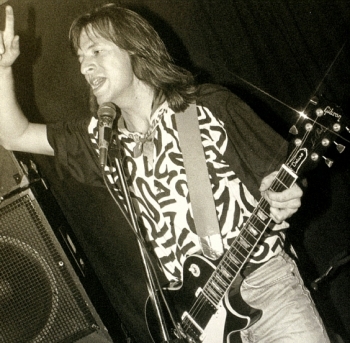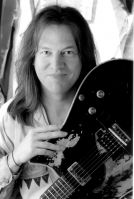Newmarket Guitar Lessons String Bending Rick Washbrook

Newmarket Guitar Lessons Bending Stings Rick Washbrook
I believe the first way to practice and achieve an accurate bend is to bend the guitar string two semi tones. Each fret represents a fret or half step, so two half steps or two frets make up one tone.
Put your 3rd finger on the 3rd string 9th fret. This is the note E. Play this note on the 9th fret 3rd sting first to get your ear hearing the exact pitch of an E note. The E note is the note you wan to bend to. Then move your 3rd finger to the 3rd string 7th fret, and bend the string up one full tone (2 half step, or two frets) to reach the E note.
Try your best to bend it accurate in pitch to match a correct a E note. Set your metronome at a slow beats per minute and with for example some where between 76 and 100. Bend the note on each beat of the metronome. This will be the exercise to create an accurate pulse which later on will be the foundation for you to create accurate full tremolo and vibrato effects while training to bend strings
Remember The E note is the note you just played on the 9th fret. Play the note you want to go to first and then bend to match it. It is as easy as that. It only took a few sentences to explain.
It is harder to perfect. You have to make sure you bend the 3rd string to the 9th fret correctly to sound a perfect E note in pitch. This is done with practice.
Soon you will bend any pitch you want at a moments notice, and accurately.
The next step is to learn is to bend half tones. This is when you bend a string one fret up. It is called a semi tone.
The steps are exactly the same except your bending up a semi tone, one fret, and not two semi tones.
You play the 8th fret 3rd string, 3rd finger which is D# or Eb (They call that enharmonic equivalence).
Sound it well for your ear to remember. Now play the 7th fret, 3rd string, and 3rd finger up one fret. You will be bending it up to the sound of as I said before D# or Eb (one fret higher). Now recognize it may be sharp or a little flat. The more you do it; with time soon right away will be able to identify the correct or incorrect pitch of the bend, practice, practice.
This is a good exercise a lot of pro players you will hear do in there solos’. Choose the second string this time because it is thinner and easier to bend on your electric. Now play the 2nd sting, 10th fret, 3rd finger. First get use to being up there on the fret board and bend the 2nd string to match the 12th fret tone. Make sure you sound the note on the 12th fret first before you try bending the 2nd string, 10th fret, up to the pitch of the 12th fret, second string.
The next thing to improve would be your vibrato and tremolo on the bends of the fretted notes. Get in touch with me I have a whole lesson on this. Larry Carlton has a great lesson on this as well. I took some of his ideas and added them to mine. I will enjoy sharing them with you
This is the real stuff that separates the men from the boys. I can show you more exercise to improve very smooth vibrato and fast tremolo effects using the metronome with my method
Ok, this is awesome. Play a major scale with the technique you know now about bending strings. Sing only a 3 note scale. Do, Ra, Me.
Here is a more advanced bending technique using a scale.
Eexample #1.
Start on the 2nd string, 3rd finger, 10th fret, you’re starting note on the 10th fret is A note. The next note of a A scale is B, and the next note is C#, which is Sung as Do, Ra, Me. Play the notes fretted A, B, C#. They will be found on the 10th fret, 12th fret, and 14th fret. Now try the bends. I will warn bending the 10th fret up to the 14th fret is hard. The better you get you will be able to do it.
Example #2
So 3rd finger stays on the 2nd string, 10th fret and bend up sounding in the A Key, Do, Ra, Me, which is like I said A, B, C#. It’s a very cool stretch. Then practice up and back down. These are the notes A, B, C#, B, A. or Do, Ra.Me,Re,Do . This is an awesome exercise. Really pay attention to your pitch and keep it perfect. Make sure your "arrival pitch destination" of a bend is perfect.
I encourage guitar players to practice bends in as many different areas on the fret board as possible. To go even further, practice doing bends larger than a full bend. Try a full and a half bend for instance. Bend strings and, see how quickly you can play the "arrival pitch destination" of a bend, and how quickly you are able to bend to that pitch.
This is just the beginning. I encourage you to get these basics down first before trying something harder.
Listen to many guitar players
I have explained basics for whole tone bends and half tone bends.
Newmarket Guitar Lessons Bending Stings Rick Washbrook
By: Rick Washbrook
http://www.washbrookmusic.com
(416) 824-3377
Rick Washbrook Says
“Good teachers don't settle for simply doing something, I encourage my student’s to really in-vision their progress, and have a good practice regime so they can do better. I have always aimed for the best and expect the best out of my students.”
